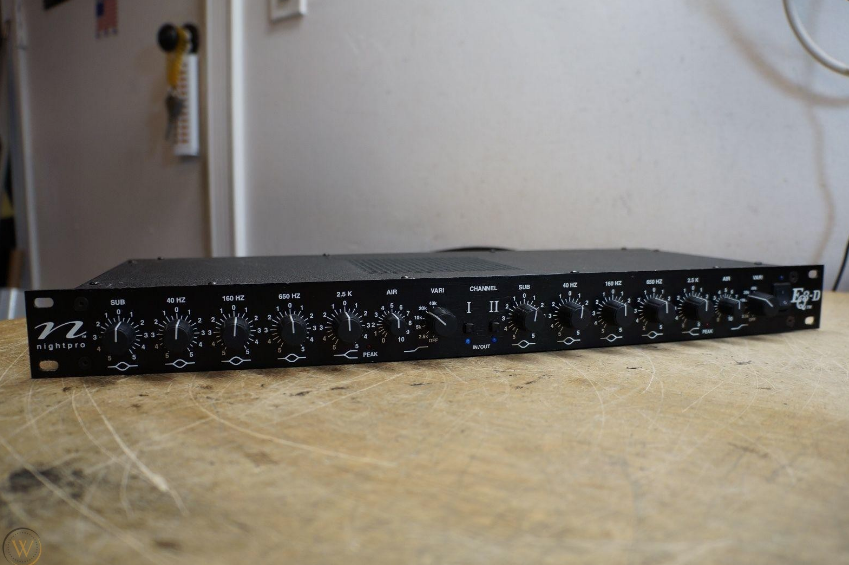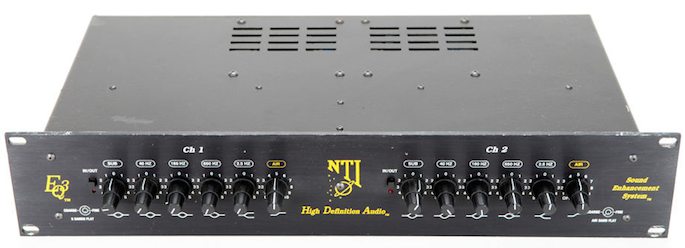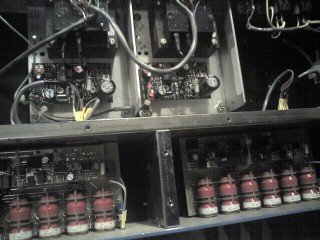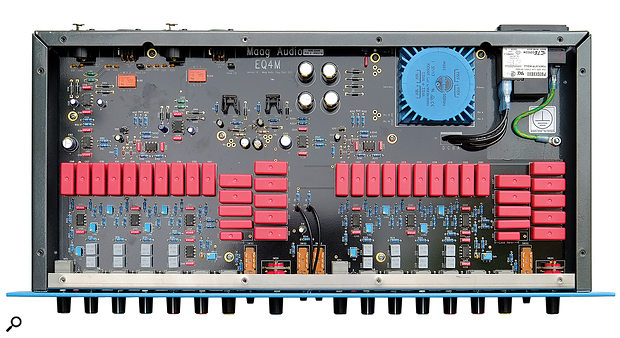You are using an out of date browser. It may not display this or other websites correctly.
You should upgrade or use an alternative browser.
You should upgrade or use an alternative browser.
3D "AIR" EQ - "Night EQ" PCB's Complete!
- Thread starter khstudio
- Start date
Help Support GroupDIY Audio Forum:
This site may earn a commission from merchant affiliate
links, including eBay, Amazon, and others.
shot
Well-known member
Finally I found time to take these boards out of the drawer and start fiddling around with this topology (bandwidth-limited non-inverting gain stages in parallel with 1st order -6dB slopes).
Am using 50K rev log pots without centre detents and matched and adjusted the pots for centre position (at about 12 o'clock'ish). R30 and R48 are adjusted accordingly (fixed higher resistor and trimmer in parallel to prevent amp from running open loop should trim fail) and centre positions are 'aboutish' spot on when switching internal bypass per board as well as additional relay-hardbypass for both boards. Also stuck a 150pf cap across the 22pf, so 172pf instead of my calculated 155pf, but good enough for my hearing.
I still have to rip out one leg of all filter resistors to measure caps to get all filters (caps AND resistors) as close to ideal values as possible. This latter is the second reason these fully populated boards had been sleeping for so long. Time, time, time is on my side, yes it is
Am using 50K rev log pots without centre detents and matched and adjusted the pots for centre position (at about 12 o'clock'ish). R30 and R48 are adjusted accordingly (fixed higher resistor and trimmer in parallel to prevent amp from running open loop should trim fail) and centre positions are 'aboutish' spot on when switching internal bypass per board as well as additional relay-hardbypass for both boards. Also stuck a 150pf cap across the 22pf, so 172pf instead of my calculated 155pf, but good enough for my hearing.
I still have to rip out one leg of all filter resistors to measure caps to get all filters (caps AND resistors) as close to ideal values as possible. This latter is the second reason these fully populated boards had been sleeping for so long. Time, time, time is on my side, yes it is
Pulled resistor legs on the PCBs today to measure caps in all filter sections. Then I ran the numbers. The idea was to first put additional small value caps in parallel (PCB underside) to get closer to the calculated cap values without having to add too many trimmers in the filters, which in turn messes with the individual gain stages.
But, turns out that my caps are all TOO good -- something like btw 1.957 to 1.996 for the 2uf caps and btw 196.7 to 200+ for the 200n) -- and calculations tell me I need cap values that are lower. THWARTED !! Will try to scan the stash for resistors that are so badly off they might actually match the installed caps. I still shy away from adding up to 10 trimmers per channel just for the filters :
So, funny circuit this one indeed. Makes me wonder how the original commercial unit (with patent, what?!) could have ever been advertised for mastering in the first place An additional opamp gain stage between each filter section and pot (four or better six amps per channel) might have solved this elegantly. Still an option in DIY though, hmm...
An additional opamp gain stage between each filter section and pot (four or better six amps per channel) might have solved this elegantly. Still an option in DIY though, hmm...
On the other hand, cap values might drift off over time. So being able to trim the HP and LP filters individually is not too bad an idea. Maybe I first focus on the 160Hz and 640Hs only -- as I can even hear one channel being off around there. Unit is gonna look ugly inside, haha !
But, turns out that my caps are all TOO good -- something like btw 1.957 to 1.996 for the 2uf caps and btw 196.7 to 200+ for the 200n) -- and calculations tell me I need cap values that are lower. THWARTED !! Will try to scan the stash for resistors that are so badly off they might actually match the installed caps. I still shy away from adding up to 10 trimmers per channel just for the filters :
So, funny circuit this one indeed. Makes me wonder how the original commercial unit (with patent, what?!) could have ever been advertised for mastering in the first place
On the other hand, cap values might drift off over time. So being able to trim the HP and LP filters individually is not too bad an idea. Maybe I first focus on the 160Hz and 640Hs only -- as I can even hear one channel being off around there. Unit is gonna look ugly inside, haha !
electrog
Well-known member
There were two versions of this eq available - the standard 1u version and another that, I assume, was aimed at mastering. This was in 2u format and had concentric stepped switches for boost/cut with a pot in the center for fine adjust. How well the components were matched in that version is anybody's guess...
Never had my hands on any. The SOS article said good for mastering but probably not for stereo material, which leaves Mid/Side processing.
Ran more numbers and with close to schematic cap values and pretty good resistors, the limited-bandwidth 'filters' yield frequencies that are unevenly off on average between -1.2 to -2.5 percent (-3.1 the worst with cap and resistor values almost identical as per schematic).
Also quickly ran numbers to find resistor combos (up to three, in series and in parallel) for the exact required values. Max of two series resistors on top of PCB, parallel on underside. I guess this shall keep me busy for a while. Will have to see how it goes. Trimmers, yes, possibly.
Ran more numbers and with close to schematic cap values and pretty good resistors, the limited-bandwidth 'filters' yield frequencies that are unevenly off on average between -1.2 to -2.5 percent (-3.1 the worst with cap and resistor values almost identical as per schematic).
Also quickly ran numbers to find resistor combos (up to three, in series and in parallel) for the exact required values. Max of two series resistors on top of PCB, parallel on underside. I guess this shall keep me busy for a while. Will have to see how it goes. Trimmers, yes, possibly.
Script said:Never had my hands on any. The SOS article said good for mastering but probably not for stereo material, which leaves Mid/Side processing.
I use the Night Eq for mastering for many 13 years now, used the hardware unit for around 5 years, but after that I just use the Maag plugin version because I can automate it so it's more flexible,has zero hiss and does exactly what I was doing in the hardware unit.
I still have a DIY version of this, that I prefer to the original unit since it has center detent pots.
electrog said:There were two versions of this eq available - the standard 1u version and another that, I assume, was aimed at mastering. This was in 2u format and had concentric stepped switches for boost/cut with a pot in the center for fine adjust.
Yes there were 2 hardware units, although I really don't know if they were from the same company or different companies, although they seem to be based in the same circuit and layout.
The 1U unit was branded "N Nightpro"model EQ3-D, it used Pots without center detent, it seems to have come in 3 different colours, Blue, Black and some greyish/Blueish:



Then there was a 2U unit branded "NTI" model EQ3 and has written "High Definition Audio" "Sound Enhancement System", it used Stepped grayhill switches and had Dual PSU's and shielding between channels probably to reduce the crosstalk between L and R, they seem to have come in 2 different colours, Blue and Black:



I had the NightPro 1U unit and used that extensively but never seen or used the NTI unit in any studio or country I worked with.
I don't know if there was any relation with Nightpro company and NTI, the product was obviously related, if anyone has any info please let us know.
A also a nice curiosity is the this EQ was never called the "Night EQ" it was always model EQ3. But is seems people started call it the Night EQ over the years, that makes me think also the Nightpro unit was much more widespread than the NTI unit.
Maag also released a reissue of the Nightpro EQ3-D, called the EQ4M with some improvements over the original:
"The main technical improvement is down to a decision to increase the power rails to ±18V, raising the headroom margin to a whopping +29dBu (about 8dB more than the 500-series EQ4). The EQ4M also adds a relay hard-bypass, an adjustable input attenuator, an extra 15kHz option on the Air Band EQ section, and the use of detented rotary controls to enable more consistent settings."
https://www.soundonsound.com/reviews/maag-audio-eq4m


"The main technical improvement is down to a decision to increase the power rails to ±18V, raising the headroom margin to a whopping +29dBu (about 8dB more than the 500-series EQ4). The EQ4M also adds a relay hard-bypass, an adjustable input attenuator, an extra 15kHz option on the Air Band EQ section, and the use of detented rotary controls to enable more consistent settings."
https://www.soundonsound.com/reviews/maag-audio-eq4m


electrog
Well-known member
Interesting - first time I've seen the black versions. I had the blue "NTI EQ3" with the switches for a little bit on loan many many moons ago. I'm pretty sure all the versions are from various iterations of the same company.
Maag is, I believe, also some of the people that were involved in NightPro/NTI.
Maag is, I believe, also some of the people that were involved in NightPro/NTI.
electrog said:Maag is, I believe, also some of the people that were involved in NightPro/NTI.
"Cliff Mäag served as the Production Manager at the NTI and Nightpro companies. It was at the latter that he designed the Nightpro PreQ3 and EQ3D equaliser products"
My guess is: Not matched atall. There is hardly one single resistor that could posibly match the entire tolerance spectrum of a cap value (even if iclosest to ideal). Even when using 0.1% tolerance caps, the circuit would still require inserting the weirdest of resistor values like 1243, 19899 etc. Tedious work and it would mean custom-built / expensive.electrog said:How well the components were matched in that version is anybody's guess...
At least for the 3DEQ DIY project, I can confirm that the circuit is outstandingly / annoyingly sentive to component tolerance. And that's exactly what makes this DIY project interesting
Matched a total of 20 resistor combos to match my optimum calculated cap-derived values. It took longer than I had hoped but not as long as expected. I used an online calculator that suggests up to three resistors in series and parallel to derive any desired value. The rest is trial and error with real-world resistors.
Examples:
I need 507R on one channel, 506R on the other. Found one of them in the 511R stash. Same with 4998 in the 4K99 stash, I think. Overall only three single-resistor solutions. A couple of values are two resistors in series. But the majority is two resistors in parallel. I have many resistors with unusual values flying arond, which makes it easier. Luckily, I never had to used three resistors (i.e. all in parallel or one resistor in parallel with two in series).
Deviation from my optimal calculated resistor values is now +0.116% in one of the 640Hz slopes. Finding the exact values turned out to be a slightly tiring (although usually I enjoy my matching meditations) especially in the low resistance value areas, where 126R4 or 126R8 (for the 640Hz slopes) makes a difference when 126R6 is needed (in my case, 126R4 was 1.7Hz off, not much indeed, but once at it, why not go the full way). Same with the 1280Hz slopes (schematic says 64R9, but I need 63R6 and 63R1). This made me think that using lower-value caps for those bandwidth-limiting slopes might yield closer (matching) results.
Trimmers in parallel with a fixed resistor are probably still the better/faster option, but it gets tight on the boards. And for me, this is an academic excercise anyway. So I can't wait for caps to degenerate over time and then having to do the parallel matching of fixed resistors all over again
Now I need to make some time to solder it all in and then, as a last step, figure out how to solve the gain deviations inevitably introduced in all stages. Will probably simply offset the 0 points on the knobs (I have no centre detents), because unit will be used in Mid/Side processing only and I do not need full boost or 'cut' (i.e. boost below unity gain) anyway.
Examples:
I need 507R on one channel, 506R on the other. Found one of them in the 511R stash. Same with 4998 in the 4K99 stash, I think. Overall only three single-resistor solutions. A couple of values are two resistors in series. But the majority is two resistors in parallel. I have many resistors with unusual values flying arond, which makes it easier. Luckily, I never had to used three resistors (i.e. all in parallel or one resistor in parallel with two in series).
Deviation from my optimal calculated resistor values is now +0.116% in one of the 640Hz slopes. Finding the exact values turned out to be a slightly tiring (although usually I enjoy my matching meditations) especially in the low resistance value areas, where 126R4 or 126R8 (for the 640Hz slopes) makes a difference when 126R6 is needed (in my case, 126R4 was 1.7Hz off, not much indeed, but once at it, why not go the full way). Same with the 1280Hz slopes (schematic says 64R9, but I need 63R6 and 63R1). This made me think that using lower-value caps for those bandwidth-limiting slopes might yield closer (matching) results.
Trimmers in parallel with a fixed resistor are probably still the better/faster option, but it gets tight on the boards. And for me, this is an academic excercise anyway. So I can't wait for caps to degenerate over time and then having to do the parallel matching of fixed resistors all over again
Now I need to make some time to solder it all in and then, as a last step, figure out how to solve the gain deviations inevitably introduced in all stages. Will probably simply offset the 0 points on the knobs (I have no centre detents), because unit will be used in Mid/Side processing only and I do not need full boost or 'cut' (i.e. boost below unity gain) anyway.
Spend some time on getting the gains right using the pots on the front. The best I get is mild dips and bumbs with a max of about 0.2 dB off unity gain. Not bad, I'd think.
For me this was an academic investigation into how well 'filter' frequencies can be optimised using only resistors (not trims). I knew from the start that this was a futile endeavour, because I use pots without centre detents. So it was clear that by the time I screwed the knobs onto the pot shafts, the centre positions would most likely be slightly off again -- yet they are all at about 12 o'clockish now.
Centre-detented knobs are still an option, although knobs without centre-detents and without indicators might even be more enticing to me. With only a few knobs per channel, I now simply dial the knobs without looking until it sounds good (in testing I mostly ended up with mild settings anyway), and if I need zero, I simply flip into full hardbypass.
To anyone who builds this unit in future:
- there is no need for high-precision caps or resistors. Get caps, install and measure them. Then the correct resistor values need to be calculated anyway. Could use resistor combos for that, but trims are probably better.
- meticulously matching of caps makes sense only in the air bands (L and R)
- stepped pots are an option but I'd believe they would require that the gain of the individual stages is spot on before any signal hits those stepped volume switches (probably a trimmer before the stepped volume switches ?).
- full boost (up to 20dB on paper) is most likely not needed
- clip indicators can easily be implemented (using the two unused opamp halfs of U4 for input and U6 for output), but I skipped this as I don't use that much gain in the first place
- a volume knob before the output might be useful (or not)
- highly recommended is being able to hard-bypass (at least my unit sounds a tiny tad 'bright' and/or a tiny tad less 'beefy' in the lower range even in soft bypass -- not necessarily a bad thing though.
For me this was an academic investigation into how well 'filter' frequencies can be optimised using only resistors (not trims). I knew from the start that this was a futile endeavour, because I use pots without centre detents. So it was clear that by the time I screwed the knobs onto the pot shafts, the centre positions would most likely be slightly off again -- yet they are all at about 12 o'clockish now.
Centre-detented knobs are still an option, although knobs without centre-detents and without indicators might even be more enticing to me. With only a few knobs per channel, I now simply dial the knobs without looking until it sounds good (in testing I mostly ended up with mild settings anyway), and if I need zero, I simply flip into full hardbypass.
To anyone who builds this unit in future:
- there is no need for high-precision caps or resistors. Get caps, install and measure them. Then the correct resistor values need to be calculated anyway. Could use resistor combos for that, but trims are probably better.
- meticulously matching of caps makes sense only in the air bands (L and R)
- stepped pots are an option but I'd believe they would require that the gain of the individual stages is spot on before any signal hits those stepped volume switches (probably a trimmer before the stepped volume switches ?).
- full boost (up to 20dB on paper) is most likely not needed
- clip indicators can easily be implemented (using the two unused opamp halfs of U4 for input and U6 for output), but I skipped this as I don't use that much gain in the first place
- a volume knob before the output might be useful (or not)
- highly recommended is being able to hard-bypass (at least my unit sounds a tiny tad 'bright' and/or a tiny tad less 'beefy' in the lower range even in soft bypass -- not necessarily a bad thing though.
Just to finish this off. I had tuned the gain stages using 'filters engaged' versus 'soft bypass'. Also checked 'soft' versus 'hard' bypass. There was a slight offset in AC readings from input to output. Tuned it to exact readings using input trimmer and now the unit 'feels' a tad louder when engaged (could be the two Burr Browns I used as I had not enough NE5532s). Anyway, I guess that a tad more subjective loudness when the unit is engaged turns it into a real 'product' , hehe ; )
Hi all. I recently purchased a used "NIGHT EQ3-D" and the 650 Band is not working on both channels. I can't seem to locate the build instructions for these (schematic and layout). Also, can these be calibrated for matched stereo EQ ?
I also got a got the "EQ S800" in the deal so if you also have schematics, etc... for that one also I would appreciate!
Thanks so much!
Mike.


I also got a got the "EQ S800" in the deal so if you also have schematics, etc... for that one also I would appreciate!
Thanks so much!
Mike.


Have you opened the unit ? DIY version is all thru-hole. Commercial units SMD, I believe.
Some builders in this thread opted for stepped controls on the DIY one (for mastering). How-to info is somewhere above.
If it's the DIY boards (by khstudio and peterc , IC U2 is for 160Hz and 640Hz. Swap ICs (but only with same dual op amps like NE5532) to see what happens. Or it's both 640Hz pots being faulty simultaneously (unusual).
Some builders in this thread opted for stepped controls on the DIY one (for mastering). How-to info is somewhere above.
If it's the DIY boards (by khstudio and peterc , IC U2 is for 160Hz and 640Hz. Swap ICs (but only with same dual op amps like NE5532) to see what happens. Or it's both 640Hz pots being faulty simultaneously (unusual).
Hi all. I recently purchased a used "NIGHT EQ3-D" and the 650 Band is not working on both channels. I can't seem to locate the build instructions for these (schematic and layout). Also, can these be calibrated for matched stereo EQ ?
If you didn't find the schematics it's because you didn't search this thread as the schematics are published here.
Also the answer to you match stereo EQ is discussed deeply in this thread, so that questions was already answered.
GroupDIY Rules: Read before posting in any of the forums!
6. Use the search function (thoroughly) before posting.I'm currently designing a PCB in eagle using the schematics of Kevin Hogan (found it here on the forum, I guess in this thread - can't find it now to link to, sry).
Could someone measure the distance between the pots (from center to center)? I really like the front panel layout I see on pics of your builds here and would like to do something similar
Currently I chose 27.94mm / 1100 mil from eyeballing..
Could someone measure the distance between the pots (from center to center)? I really like the front panel layout I see on pics of your builds here and would like to do something similar
Currently I chose 27.94mm / 1100 mil from eyeballing..
If you design a PCB...
[veer]
Why not address the quirkiness of the 'filter' sections ?
Making the pots stepped really is the way to go here.
Might also consider proper line receiver and driver (e.g. THAT124x l& 1646).
Or not. Just thinking out loud
[/veer]
[veer]
Why not address the quirkiness of the 'filter' sections ?
Making the pots stepped really is the way to go here.
Might also consider proper line receiver and driver (e.g. THAT124x l& 1646).
Or not. Just thinking out loud
[/veer]
Similar threads
- Replies
- 3
- Views
- 408















